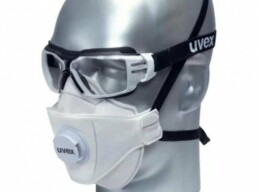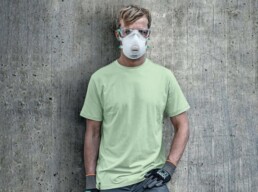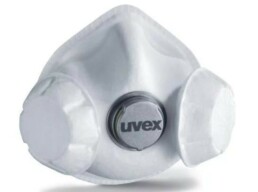Particle-filtering half masks are mainly used as PPE in a work context, but also in domestic situations, to filter inhaled air. This prevents hazardous particles, dust, aerosols, viruses, bacteria and other pollutants from the air from entering and damaging the respiratory tract. In this blog article, we explore the differences between masks with and without a valve and tell you about the selection of masks offered by uvex.
How are masks with a valve constructed?
FFP1, FFP2 or FFP3 masks with a valve are generally constructed in the same way as masks without a valve: our flat-fold and cup-style masks cover both the mouth and nose and sit directly against the skin of the face thanks to a sealing lip. Two headbands or a single strap allow the mask to be secured at the back of the head without slipping. The round 360° exhalation valve is positioned at the centre of the cup-style mask.

What is the function of the exhalation valve?
The exhalation valve makes breathing out while wearing a respirator with a valve more comfortable in three different ways:
- A valve decreases exhalation resistance because the air is able to escape through the valve more easily.
- Respirators with a valve accumulate less moisture.
- Heat is also less likelyto accumulate under a mask with a valve as the exhaled air can be released directly into the environment.
The main protective function of masks with a valve is to filter the inhaled air, but not the exhaled air. In other words, a mask with a valve only protects the person wearing it. Other people in the vicinity therefore need their own mask with or without a valve in order to be adequately protected if they come into contact with viruses or bacteria, for example. This is consistent with the principle that any form of PPE should protect the wearer from the effects of the environment.
Do masks with a valve offer less protection than models without a valve?
Dust masks with a valve protect the wearer against hazardous substances in the air just as well as masks without a valve (wearer protection). Because a mask with a valve does not filter aerosols in the exhaled air, the exhaled air passes through the mask into the ambient air. In this case therefore, other people are not protected. In a work environment in which all other employees are also wearing respiratory protection, particle-filtering half masks with a valve are recommended: they are significantly more comfortable than models without a valve and can even be worn for 150 minutes instead of only 75 minutes at a time before a recovery period of 30 minutes is required. If you need to use a particle-filtering half mask in public or private spaces to protect yourself and others (wearer protection and protection of others), it is better to use masks without a valve. The uvex masks with a valve include both single-use and reusable models.
Our (dust) masks with a valve are certified in accordance with the EN 149:2001+A1:2009 standard for particle-filtering half masks and fulfil the requirements for personal protective equipment.

Are masks with a valve more comfortable than masks without a valve?
Thanks to the improved air exchange through the valve, FFP1, FFP2 or FFP3 masks with a valve make breathing significantly more comfortable than masks without a valve. Anyone who has ever worn an FFP2 mask without a valve and inhaled the warm exhaled air in the mask can imagine the positive difference.
What kinds of masks with a valve does uvex offer?
To ensure you experience a high level of wearer comfort at work despite wearing a mask, we offer FFP1, FFP2 and FFP3 masks with an exhalation valve, which have different degrees of filter performance in accordance with their level of protection. uvex also offers FFP1 and FFP2 masks without a valve. In our blog article, you can read about how respirators work and the effect of the different protection classes FFP1, FFP2 and FFP3.
We offer three types of respirators:
- Respirators with a 360° exhalation valve
- Respirators with an inhalation valve
- Respirators without an exhalation valve
Our FFP3 uvex silv-Air 2310 planet mask is a sustainable product: the 360° exhalation valve is made of 95 per cent recycled acrylonitrile-butadiene-styrene copolymers (ABS), while the headband attachments are made of 100 per cent recycled polypropylene (PP) – for a mask that aligns with the values of our motto “protecting planet” and helps conserve valuable resources.

What are the advantages of masks with an inhalation valve?
In addition to masks with an exhalation valve, our range also includes high-performance models such as the uvex silv-Air e 7333 preformed mask, which have an exhalation valve and two inhalation valves. The side valves ensure up to 40 per cent less inhalation resistance and thus a more comfortable air exchange. In addition, the two extra air chambers ensure a pleasantly cool climate inside the mask. These special masks with both valve types are also certified in accordance with the EN 149:2001+A1:2009 standard.

Enjoy lower breathing resistance with uvex masks with a valve
Ensure you and your employees can work more comfortably by ordering filtering half masks with valve(s) and thus combining occupational safety and comfort! These masks allow you to work safely and breathe as comfortably as possible, even in zones with hazardous substances. Further useful information about uvex’s different respirators can be found in our catalogue in the Breathing Protection section from page 159.